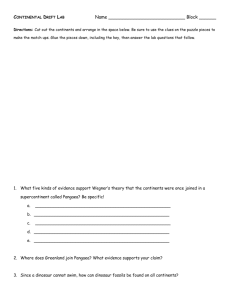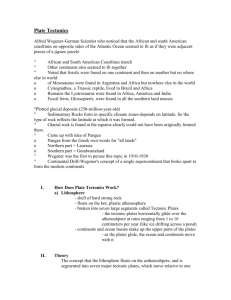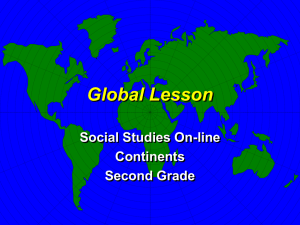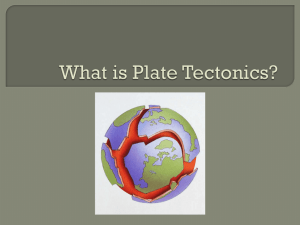Plate Tectonics & Evolution
advertisement
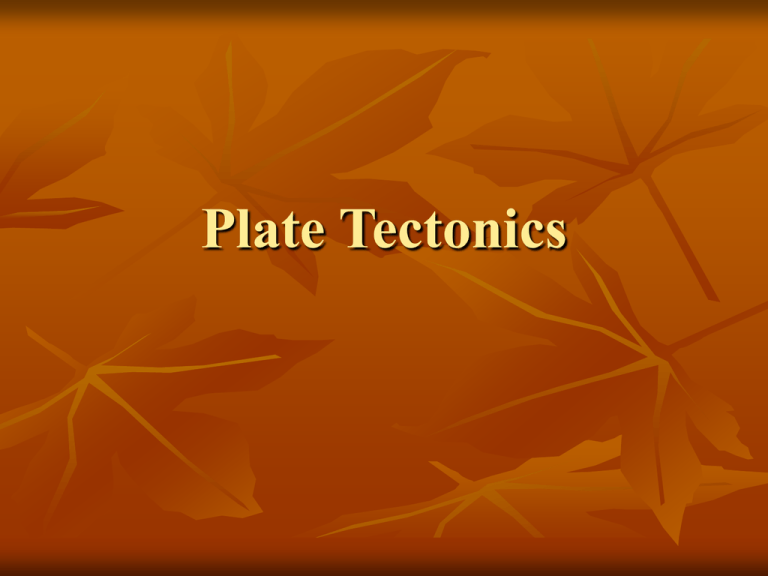
Plate Tectonics Plate tectonics A theory that states that the earth’s crust is made up of a number of plates which move over a liquid crust that get created and destroyed over time. Moving Plates The force for these movements is derived from magmatic convection cells in the asthenosphere of the mantle. The upward portion of these cells are known as magmatic plumes. When they hit the crust, the plate above is melted and forced to spread creating a spreading ridge as they are adding new continental material (constructive margin) to the edges of these plates. Evidence supporting plate tectonics Ages of oceanic crusts get older as one moves away from a spreading ridge. Ages of oceanic sediments on top of the crust gets older as one moves away from a spreading ridge. Rock formations with the same mineral content and age existing on opposite continental shores. The eastern most tip of south America and the African Congo both have the same iron ore rock formation. Rock formations are also shared between Newfoundland, Canada and the west coast of Ireland and southern India and South Africa. Evidence supporting plate tectonics Stationary hot-spots "burn" trails into moving continents. Magnetic anomalies showing variations in the Earth’s magnetic field strength are arranged in bands parallel to each other on either side of the spreading ridges. Evidence supporting plate tectonics Magnetic polarity reversals patterns are preserved as the rock formed, show symmetry about spreading ridges. The margins or edges of some continents have shapes that indicate that they once fit together. (i.e. South America fitting into Africa.) Evolution and Biodiversity Influenced by Plate Activity Pangea Two hundred million years ago (Ma), research suggests that all the continents where one large mass which was named Pangea. Terrestrial organisms were able to migrate across all the continents and were only limited by their biotic potential. Biodiversity As Pangea began to separate into separate continents 130 Ma, creating physical barriers such as seas, restricting migration to within the continents. Gene pools of species are separated and as they are exposed to different physical (i.e. climate) and biotic (i.e. change in predators) conditions, each portion of the species adapts differently and eventually forms new species on the separated continents. This process is known as speciation. Biodiversity Changes in physical and biotic conditions will also lead to the creation of new species increasing the diversity of habitats and niches. This also provides the space for new species to evolve into these habitats. The end result of the separation of Pangea into today’s continental configuration is that plate tectonics has been one of the main driving forces promoting biodiversity or organisms. Biodiversity In addition to continents separating, some like India left south Africa and Antarctica and joined up with Asia. It took with it organisms that were typical to Antarctica and Australia. Over the next 100 Myrs these organisms evolved in isolation from any other continent until it formed a land bridge with Asia. Since 30 Myrs ago the species on India and Asia have been re-adapting themselves causing additional biodiversity. Biodiversity Australia has one of the most unique sets of organisms as it and Antarctica have been separate from all the other continents for the last 130 Myrs. Australia separated from Antarctica about 50 Myrs ago. This extreme isolation over such a long period of time supports Darwin’s theory of evolution in that this part of the world has the most unique organisms. Australian species have had such limited contact with species from other continents that they have only needed to adapt to their particular set of species and climate. No re-adaptation to other species from other continents has occurred until the arrival of the Europeans. Biodiversity The splitting up of Pangea 200 million years ago had the following effects on species diversity and distribution. a) Species gene pools or populations where split as Pangea separated. b) New habitats were created due to a change in biotic and abiotic factors such as climate (temperature and moisture), changes in species relationships, and topography. Biodiversity c) New niches were made available and filled causing further adaptation of species to new conditions thus modifying the local ecosystem. d) Species relationships change with respect to mutualism, predation, and competition. Species need to modify food source, protection, and dependence patterns in the food web. e) Speciation: is the creation of a new species when a gene pool of one species is split, exposed to new conditions to which each pool adjusts to. Different genetic traits are passed on to offspring. A new species evolves once the 2 original populations cannot mate. Biodiversity Rejoining of plates such as India and Asia. 30 Ma ago caused the following. a) Migration of one species into the territory of another introduces new forms of competition and predation that existing species need to adapt. b) Further speciation is generated and modified as they come into contact with a variation of the original gene pool. Biodiversity Extreme isolation such as Australia and Antarctica. 130 Ma of isolation. a) As no new predators are introduced over a long period of time speciation is limited to changes in abiotic factors such as climate and topography. b) Evolution tends to slow down and become more specialized if there are fewer stresses and ecosystem changes. c) Species evolve separately from original gene pool and tend to be very different from other areas with more contact with the original gene pool.

